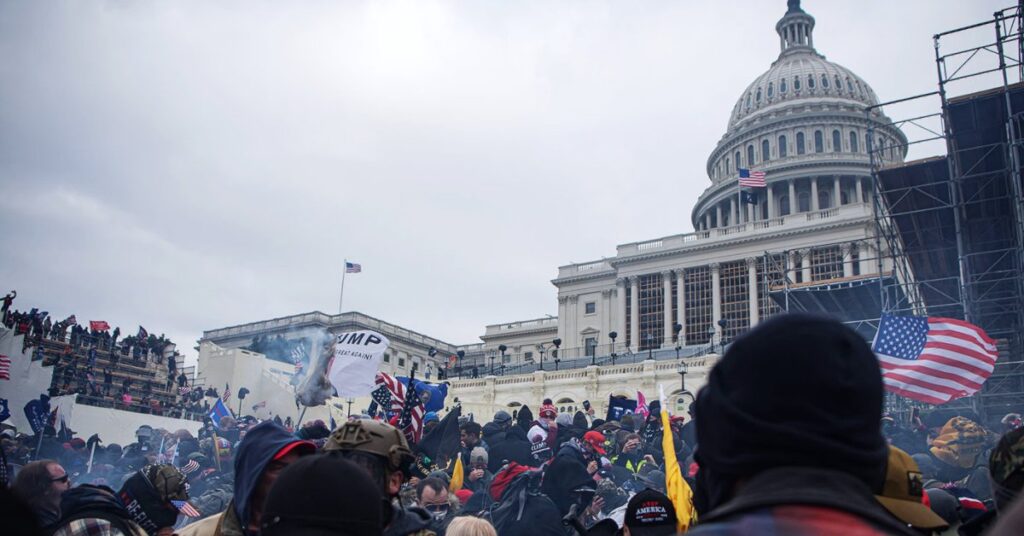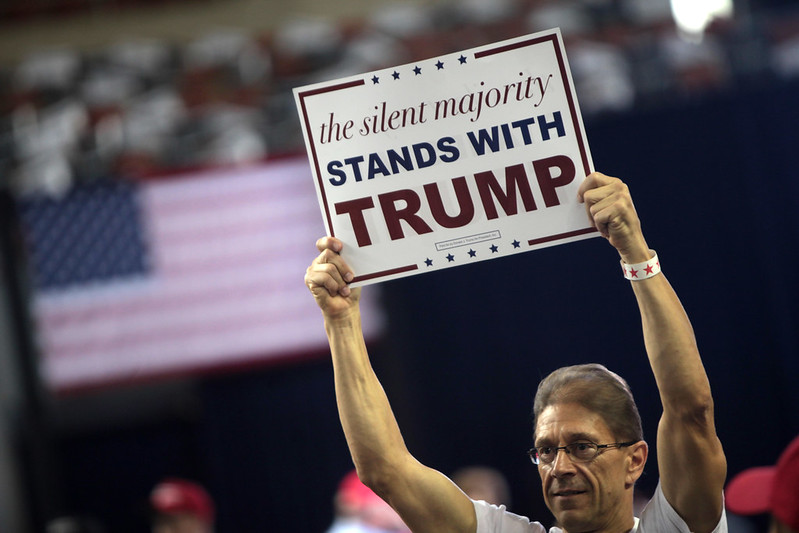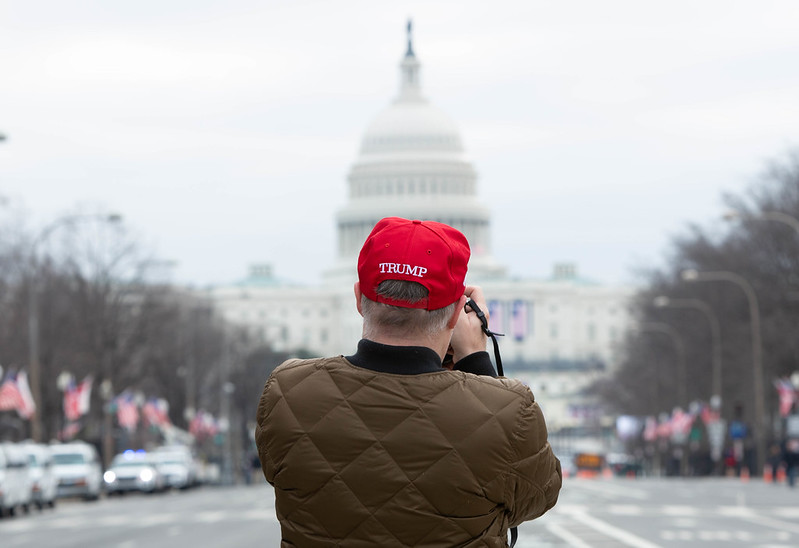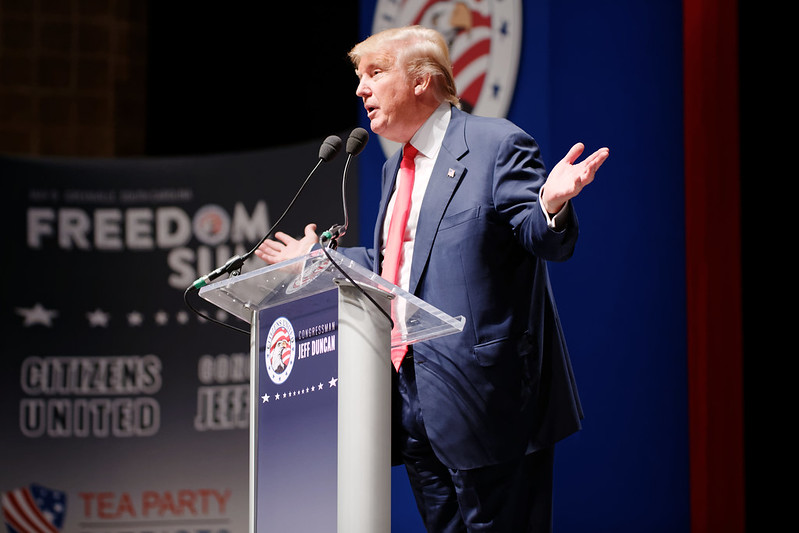
The Trump-inspired Capitol riots were a stunning, and disgraceful, reminder that far-right violent extremism and white-nationalist terrorism are on the rise, and that racial bias and double standards in law enforcement are a fact of life in this country.
But while much of the media commentary about this unprecedented right-wing insurrection has appropriately focused on racism and stark differences between the police response to Wednesday’s overwhelmingly white mob and Black Lives Matter protestors over the summer, another crucial part of the story has mostly escaped notice and scrutiny: the fact that the vast majority of those who rioted were not just white people, but white men.
To explore this critical dimension of the story, Ms. contributing writer Jackson Katz, the creator and co-writer of the new documentary film “The Man Card: White Male Identity Politics from Nixon to Trump,” sat down with Jeremy Earp of the Media Education Foundation for a wide-ranging conversation about what the riots tell us about the deep strain of white-male grievance and rage that’s been animating right-wing political culture in the U.S. for decades.
This interview has been edited for clarity.
JEREMY EARP: For years, you’ve been writing and talking about the ways right-wing political leaders, conservative media commentators, and far-right militants explicitly feed off perceived threats to white male centrality and traditional ideas about manhood. As you watched the mobs that Trump unleashed on the U.S. Capitol Wednesday, was any of this going through your mind?
JACKSON KATZ: Definitely. I was obviously outraged and concerned as an American citizen, but I also experienced Wednesday’s events through the lens of media spectacle: a throng of aggrieved white men, and some women in supporting roles, engaged in a pathetic display of performative patriotism and masculine bravado while the whole world was watching.
In many ways it was a perfect distillation of the essence of Trumpism: heavy on grievance, symbolism and perceived victimhood, and light on any realistic strategy for doing anything to solve our society’s myriad and complex problems in the 21st century—including the problems of millions of frustrated and alienated white men.
EARP: Nevertheless, it was hard not to notice how reporters and media commentators repeatedly referred to the rioters with race- and gender-neutral terms like “Trump supporters,” “rioters,” “protesters” and “people.”
You’ve written a lot about the phenomenon of gender-neutral language in media discourse and how it can work both to conceal and reinforce existing power relations. In your view, was that the case here?
KATZ: I think so, yes, and I think it’s partly because of an analytic blind spot rooted in the fact that we’re not used to seeing dominant groups as “groups” at all. For example, people often assume the word “race” refers to people of color rather than whites, who often go unexamined as a group, remain at a privileged remove, and serve as the taken-for-granted norm against which all others are measured. In other words, they’re just generic people.
In the case of the rioters, this obviously has the effect of hiding the white privilege, and male privilege, that was on display in this overwhelmingly white male mob, and as a result blocks meaningful discussion about the ways racism, male dominance, and white male identity politics might have been implicated in what we saw.
I’m not saying this is a conscious choice made by commentators or journalists—after all, they absorb the same linguistic and cultural blind spots we all do—but it’s nonetheless one of the many ways that power insulates itself from criticism and introspection.
EARP: Whether it’s conscious or not, do you think this failure to foreground race when it comes to white mobs like the one that attacked the Capitol on Wednesday is one of the reasons so many people of color have been expressing outrage about the tepid police response to the rioters and arguing that things would’ve been a lot different if this had been a mob of Black people storming the Capitol?
KATZ: Yes, and I also think the failure to foreground gender and the fact this was an overwhelmingly white male mob has an impact on how we think about the gender identities of the people involved in these right-wing movements.
So much of the commentary about double-standards in media narratives about the Capitol riots is rightly focusing on race, and how different the police response would have been had the protesters storming the citadel of American democracy been Black. But at the same time, there’s been little to no mention of the fact that the vast majority of these white rioters were men.
Gender often remains hidden even when race is made visible, and I think it blinds us to a really important, and formative, part of what’s going on in these far-right movements.
EARP: It’s likely that a lot of the people who attended Wednesday’s pro-Trump rally and stormed the Capitol on his behalf were members of, or at least immersed in the rhetoric of, far right groups of white supremacists, white nationalists, neo-Nazis, Proud Boys and QAnon conspiracy cultists.
Can you say something about what Trump has meant to the rise of far-right extremists over the past few years—especially at the level of white male identity—and what these extremes might reveal about mainstream cultural forces?
KATZ: It’s always helpful to study extremist elements of social movements if you want to gain insight into the center of those movements, for the simple reason that the extremes are more likely to express the beliefs and grievances of a social or political movement in more explicit, crude and therefore clearer ways than more mainstream elements would.
This is one of the reasons I think it’s useful to read the comments sections on right-wing news sites and to listen to conservative talk radio—because it provides insight into things that conservatives in polite society would never utter. And when you do listen closely to what people on the extremes—most of them white guys—actually say, one of the things that becomes very clear, very fast, is that there are millions of frustrated and angry white men in our society afflicted with a sense of what the sociologist Michael Kimmel has called “aggrieved entitlement.” That is, they grew up with a set of cultural narratives that told them they should expect American society to grant them the same sort of advantages their fathers and grandfathers enjoyed, but have had to confront a changing world, have had to deal with the inconvenience of women and people of color fighting for equality and refusing any longer to stand on the side, and have had to navigate a global economy that’s been bleeding traditional blue-collar manufacturing jobs.
As a result, a lot of white guys have come to believe they’re being denied what they were traditionally, and they feel rightly, entitled to. So they not only experience the decline of well-paying union jobs as a loss, they also see the increasing equality of other groups as a direct challenge to their rightful centrality in the culture, and to ideas about traditional manhood itself. So, we see groups like the Proud Boys, with their open misogyny and their boasts about being “western chauvinists,” engaging in over-the-top macho performances of these grievances, doing everything in their power to recover what they see as a lost ideal of traditional masculinity and strength. But they’re by no means alone.
This obsession with manhood and displays of brute “strength” and redemptive violence runs across the whole range of white extremist groups—and in part it helps to explain the importance of guns and the valorization of the Second Amendment that are so important to contemporary right-wing identity.
That said, it’s also important to recognize how a lot of these same attitudes and beliefs and grievances have shaped mainstream conservative and Republican Party thinking and strategy for decades, and have been absolutely central to the rise of Trumpism within the GOP. In fact, I’d argue there’s no way to understand Trumpism without understanding it as a manifestation of the need a lot of white men have to project masculine strength at all costs for fear of being perceived as soft, weak and feminine.
This stuff is absolutely key to Trump’s appeal and has a lot to do with the kinds of amped-up militarism and violence and hypermasculine posturing we saw on display Wednesday at the rally and the Capitol riot. You look at some of the footage, and at other footage from right-wing rallies and events in the past, and it quickly becomes clear that a lot of this is really about white men dressing up as “real men,” arming themselves – and sometimes resorting to violence – to prove their manhood, earn respect, and avoid humiliation at a time when there are fewer and fewer opportunities for them to do that.

It’s true there are many conservatives who were—and are—outraged by the behavior of the rioters. But it’s also true that many of those same conservatives voted twice for the man who fomented and incited those riots, and who embodies the worst excesses of this sense of aggrieved white male entitlement.
On the floor of the United States Senate, Sen. Pat Toomey (R-Pa.) called Trump a demagogue, but then said he voted for him. Did he just learn on Wednesday that Trump is a demagogue? That he’s been a font of unrelenting male grievance and whining for decades?
This seemingly newfound awareness within Republican circles that Trump’s longstanding and well-documented bullying behavior and encouragement of violence is now suddenly a problem points to how normalized, and tolerated, white male grievance and pathological ideas about manhood and strength have become within the very heart of American political culture.
“This seemingly newfound awareness within Republican circles that Trump’s well-documented bullying behavior and encouragement of violence is now suddenly a problem points to how normalized, and tolerated, white male grievance has become.”
EARP: Several commentators, Van Jones and others, have suggested that we need to take a step back and figure out whether this attack on the Capitol represented the last throes of a right-wing backlash that’s been years in the making, or the beginning of a new and more dangerous phase in its continuing resurgence. What’s your take on this?
KATZ: The domestic terrorist attack on January 6 is a major historical event that has been years in the making, but I think it’s wildly overoptimistic to think it represents the end of white male backlash. I am afraid this will be with us in various forms for the next several decades. After all, we’re talking about a historic, seismic shift happening in the demography of western society—and not just in the U.S.
Each year white men are losing ground in terms of their share of the population and the electorate, but it’s more than that. The logical and moral rationale for white men’s rule has been steadily eroded by racial justice and feminist movements over the past century—and that toothpaste’s out of the tube. I think it’s tempting to see Trumpism, and the embarrassing and dangerous events at the Capitol, as a last gasp of sorts. But it’s important to remember that the racist, post-Civil War “Lost Cause” mentality that refused to let go of the Confederacy still has legs more than 150 years later, as the widely circulating image of a pathetic white guy parading the Confederate flag through the Capitol building reminded everyone.
A hundred years from now, when students are learning about the Time of Trump, that picture will be worth more than a thousand words.
EARP: News footage showed very clearly that there were a lot of women at Trump’s rally, mostly white women, and that many of them participated in the riots at the Capitol as well. In fact, the only rioter killed inside the Capitol was a woman.
How does this square with the argument you’ve made in the past that Trumpism is primarily a white-male identity movement?
KATZ: Right-wing movements in this country and elsewhere are always male-dominated and are often deeply misogynous, but of course women play important roles nonetheless.
Feminists have been researching and writing about this for many years. Kathleen Blee’s “Women of the Klan” and Kathleen Belew’s “Bring the War Home: The White Power Movement and Paramilitary America” are just two of many excellent books that address this phenomenon.
But we should also never lose sight of this central fact: Trump was elected in 2016 with an overwhelming percentage of the white male vote, and he did especially well with high school-educated white men. Just to cite one relevant stat from the exit poll data, in the 2020 presidential race in Georgia, Trump beat Biden by an incredible 83-17 percent margin among white men with high school educations. So, yes, if we want to understand the disturbing rise of right-wing politics and violence in our society, we need to figure out how and why right-wing ideology appeals to some white women, but we can’t lose sight of the fact that it appeals to far, far greater numbers of white men, many of whom have seemed to turn to Trumpism—and right-wing ideology—for a sense of belonging and to protect white male authority and centrality.

EARP: In the recent documentary “The Man Card: White Male Identity Politics from Nixon to Trump,” which you created and co-wrote, you talk extensively about the role conservative talk radio and right-wing news outlets like Fox News have played in stoking white male grievance and rage. What role, if any, do you think they played in what we saw Wednesday?
KATZ: Most feminists and progressives know how important Fox News has been in creating a kind of parallel universe of “news” and cultural commentary for millions of Americans, a universe whose gender politics are largely a reflection of the retrograde and deeply sexist and patriarchal beliefs of its founding chairman, the late Roger Ailes. But many progressives are still seemingly oblivious to the incredible power of conservative talk radio in shaping right-wing narratives about white masculinity and power. From the earliest days of Trump’s presidency, charismatic and authoritative voices on the radio – overwhelmingly but not exclusively white men – have lauded Trump’s “strength” and fearless determination to defend this country from a “radical left-wing” takeover by the Democrat (sic) Party, while simultaneously attacking the manhood not only of Democrats and liberals, but of any Republican who is too “soft” to get with the program.
It made perfect sense that last year Trump awarded Rush Limbaugh the Presidential Medal of Freedom. In many ways, Limbaugh’s career, his bombastic, hypermasculine persona, and especially his relentless and bullying hostility to feminism and women’s equality, has provided the template for Trump’s own persona and performance as president.

Incidentally, it might interest people to know that one of Limbaugh’s key talking points on the day after the disgrace that unfolded at the Capitol is that the left’s assertion of a double-standard in media coverage has it exactly backward. The problem, Limbaugh argued, is not that the police let white protesters get away with breaking the law in a way that would never have happened if most of them had been Black.
The real problem is a double standard of a different kind. All last summer, he said, the media looked the other way when Black Lives Matter activists were trashing American cities. Now when it’s right-wing protesters, the media’s all up in arms. This is the kind of alternate reality that talk radio listeners, Fox viewers, Breitbart readers, and young male devotees of a whole range of alt-right social media sites have been fed on a daily basis for decades—and it serves to make sure they’ll never look inward and actually start thinking about how much their own identities as rebel “tough guys” depends on buying into, bowing down to, and conforming to an ideology of weakness that’s based on playing the victim and whining about how unfair the world has been to them.
EARP: That reminds me of the moment in Trump’s speech at the rally when he made a very explicit effort to tell his followers that they were engaged in a kind of evolutionary battle between the “strong” and the “weak.” Their mission, he said, was “to give our Republicans — the weak ones, because the strong ones don’t need any of our help … the kind of pride and boldness they need to take back our country,” adding that MAGA nation would “never take back our country with weakness.”
What do you make of Trump’s well-known fixation on hyper-masculine strength and toughness and the way it seems to resonate so powerfully with his followers?
JK: From the beginning of his political career, Trump has understood that the best way to attract support—especially from men—is to present himself as a tough and fearless leader who will always fight back, never apologize, and never concede.
He’s also understood the value of attacking his opponents, especially his male opponents, as weak-kneed wusses with no backbone in order to prop himself up as a real man. I think a lot of his white male followers hope that by supporting him a little bit of his masculine gravitas will rub off on them.
That’s why it’s no surprise that the rhetorical strategy Trump used to provoke and inspire his die-hard supporters to storm the Capitol and interrupt the certification of Biden’s election emphasized his—and their—“strength,” as well as the supposed weakness of Republicans who weren’t okay with his attempted hijacking of American democracy.
EARP: In “The Man Card,” you also go to great pains to show how Trump’s near obsession with toughness and strength and macho bravado is less a break with Republican political strategy than a continuation of a trend that’s been decades in the making.
Can you talk about that and explain why you think it’s important to stress the continuity of Trumpism with the past?
KATZ: In “The Man Card,” we show how Trump’s relentless invocation of “law and order” during the 2016 and 2020 campaigns were lifted straight from the playbooks of George Wallace, Richard Nixon, and Ronald Reagan in the late ‘60s, ‘70s, and ‘80s.
Inherent in this trope, of course, is the racist idea that we need tough-guy leaders who have the backbone and strength to crack down on Black crime, and, most importantly, to protect white people in the suburbs. But as crucial and important as the racial subtext is here, there’s also a crucial gender subtext—one that’s received very little attention in comparison.
The fact is that political leaders—especially on the right—have employed a whole range of tough-talking, hypermasculine rhetorical strategies since the 1960s not only to tap into white anxiety and fear in the wake of the Civil Rights Act, but also to appeal more narrowly to white men unsettled by the diminution of their identity as head of the household and protectors in an era of women’s increasing equality.
As much as anything else, this is about the Republican Party working over a period of decades to brand itself as the party of “real men,” and defenders of white male centrality, while casting Democrats as soft, overly intellectual “elites” who lack the spine to lead and live in perpetual fear of a cabal of PC “social justice warriors” and radical left feminists who are hostile to traditional ideals of manhood—meaning white manhood, of course.
The fact Trump responded with complete indifference to law and order when the Capitol was being attacked and overrun by anti-American domestic terrorists the other day simply shows what’s been clear all along: his weaponization of the law-and-order trope has always been more about making a big show out of being a tough guy than it has been about actual concern for law, order, and justice.
It’s also worth noting how Trump is now turning this strategy against the heart of the right-wing Republican Party establishment itself, essentially painting any Republican politician who’s dared to cross him and his election-theft conspiracy theories as “weak,” which in many ways is of course the opposite of the truth. In fact, it’s one of the great paradoxes of authoritarian strong men movements that the men who bow down and follow their heroic leader with blind obedience and obsequiousness are cast as somehow strong while those who have the guts to take on the bully are cast as weak. It’s an Orwellian inversion of reality, and it points to the deep contradictions inherent in right-wing definitions of masculine strength, which seem to privilege bullying over standing up for the underdog, and the need to avoid humiliation, as men, at all costs.
John Stoltenberg wrote a terrific piece the other day that made exactly this point, observing that “Trump’s domination and humiliation of his morally gutless male sycophants,” and his posturing as a “swaggering bully who boasted that he could grab women by the pussy with impunity,” all comes down to his expert sense of “how to trigger and exploit other men’s fears of being wussy.”
EARP: In light of all this, what do you make of the craven attempts Senate leaders like Josh Hawley and Ted Cruz have made over the past few days to endear themselves to Trump and Trump voters by legitimizing these ridiculous and entirely fictional far-right conspiracy theories about the election being stolen?

As Trump now finally bleeds out and shrinks away, they clearly seem to be positioning themselves for presidential runs in 2024. Are these displays of loyalty to Trump an attempt to claim Trump’s mantle as a populist and to demonstrate how fearless they are in the face of elites in both parties?
KATZ: From the moment Trump came down that escalator in 2015 and announced his candidacy, Republican politicians who harbored post-Trump presidential ambitions have had to wrestle with how to position themselves as “tough” and loyal enough to merit the support of Trump’s most ardent supporters—especially his white-male blue-collar and working-class base.
Trump, a plutocrat who was driven to school in limousines as a boy, prefers the company of country club elites, and surrounds himself with ornate gold-and-lace French Versailles decor, has been able to pull off this con and position himself as a man of the people with perhaps his greatest creation of all: the iconic, and entirely fictional, character known as “Donald Trump”—a “blue-collar billionaire” who talks like an old-school barroom brawler and despite his big bank account has a deep and abiding populist concern for the “forgotten man” (and woman).
Well, now we see Josh Hawley and Ted Cruz, the two Senate leaders who led the charge to legitimize the far-right “stolen election” conspiracy theory that inspired the Capitol riot, trying to read from the same script. Both of them are now in the process of trying to pull off the same populist con and somehow spin their less-than-stellar street cred into Trumpian man-of-the-people gold.
Cruz, who has now taken to wearing a Grizzly Adams beard and has been posting hunting pictures of himself posing with dead animals with increasing frequency on social media, graduated from Princeton and Harvard Law School.
And Hawley is a graduate of Stanford and Yale Law School who did a stint teaching at the exclusive St. Paul’s School in London. In other words, like so many other self-styled Republican “populists,” these men hail from the most elite sectors of American society and support economic policies that routinely reward the wealthiest Americans and most powerful corporations at the direct expense of working people, but they nevertheless know that making bold and audacious Trumpian moves that are unpopular with their fellow elites can be a winning strategy by conveying “strength” and “toughness” in Trump’s Republican Party.
In many ways, I don’t think it’s an exaggeration to say that the future of the Republican Party, and the health of American democracy, depends in a really big way on our political leaders and commentators understanding just how much the pathologies of our current political moment are being shaped by this sorry brand of white male identity politics, and by the desperate attempts of weak men to cling to outmoded and debased ideas about what it means to be a man.
You may also like:
Our opponents are using the lame duck period—the time between now and when the new president is inaugurated, and a new Congress convenes—to do as much damage as they can. Help ensure Ms. remains strong and independent during this period of challenge and change. If you found this article helpful, please consider supporting our independent reporting and truth-telling for as little as $5 per month.





